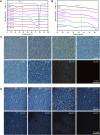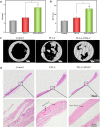Liquid Crystal Modified Polylactic Acid Improves Cytocompatibility and M2 Polarization of Macrophages to Promote Osteogenesis
- PMID: 35782509
- PMCID: PMC9247145
- DOI: 10.3389/fbioe.2022.887970
Liquid Crystal Modified Polylactic Acid Improves Cytocompatibility and M2 Polarization of Macrophages to Promote Osteogenesis
Abstract
Liquid crystalline phases (LC phases) are widely present in an organism. The well-aligned domain and liquidity of the LC phases are necessary for various biological functions. How to stabilize the floating LC phases and maintain their superior biology is still under study. In addition, it is unclear whether the exogenous LC state can regulate the immune process and improve osteogenesis. In this work, a series of composite films (PLLA/LC) were prepared using cholesteryl oleyl carbonate (COC), cholesteryl pelargonate (CP), and polylactic acid (PLLA) via a controlled facile one-pot approach. The results showed that the thermo-responsive PLLA/LC films exhibited stable LC phases at human body temperature and the cytocompatibility of the composites was improved significantly after modification by the LC. In addition, the M2 polarization of macrophages (RAW264.7) was enhanced in PLLA/LC films, and the osteogenic differentiation of bone marrow mesenchymal stem cells (BMSCs) was improved as co-cultured with macrophages. The in vivo bone regeneration of the materials was verified by calvarial repair, in which the amount of new bone in the PLLA-30% LC group was greater than that in the PLLA group. This work revealed that the liquid crystal-modified PLLA could promote osteogenesis through immunomodulation.
Keywords: bone regeneration; cytocompatibility; liquid crystal; macrophages; polylactic acid.
Copyright © 2022 Zheng, Wang, Lin, Tian, Zhou, Li and Li.
Conflict of interest statement
The authors declare that the research was conducted in the absence of any commercial or financial relationships that could be construed as a potential conflict of interest.
Figures







Similar articles
-
Smurf1-targeting miR-19b-3p-modified BMSCs combined PLLA composite scaffold to enhance osteogenic activity and treat critical-sized bone defects.Biomater Sci. 2020 Nov 7;8(21):6069-6081. doi: 10.1039/d0bm01251c. Epub 2020 Oct 1. Biomater Sci. 2020. PMID: 33000773
-
[Effects of allogeneic bone marrow mesenchymal stem cells on polarization of peritoneal macrophages in rats with sepsis].Zhonghua Shao Shang Za Zhi. 2017 Apr 20;33(4):217-223. doi: 10.3760/cma.j.issn.1009-2587.2017.04.006. Zhonghua Shao Shang Za Zhi. 2017. PMID: 28427135 Chinese.
-
Osteoblast-derived extracellular matrix coated PLLA/silk fibroin composite nanofibers promote osteogenic differentiation of bone mesenchymal stem cells.J Biomed Mater Res A. 2022 Mar;110(3):525-534. doi: 10.1002/jbm.a.37302. Epub 2021 Sep 8. J Biomed Mater Res A. 2022. PMID: 34494712
-
Dual Biosignal-Functional Injectable Microspheres for Remodeling Osteogenic Microenvironment.Small. 2022 Sep;18(36):e2201656. doi: 10.1002/smll.202201656. Epub 2022 Apr 14. Small. 2022. PMID: 35419952
-
Periosteum and development of the tissue-engineered periosteum for guided bone regeneration.J Orthop Translat. 2022 Feb 16;33:41-54. doi: 10.1016/j.jot.2022.01.002. eCollection 2022 Mar. J Orthop Translat. 2022. PMID: 35228996 Free PMC article. Review.
Cited by
-
Research Progress in Medical Biomaterials for Bone Infections.J Funct Biomater. 2025 May 21;16(5):189. doi: 10.3390/jfb16050189. J Funct Biomater. 2025. PMID: 40422853 Free PMC article. Review.
-
Biomimetic Liquid Crystal-Modified Mesoporous Silica-Based Composite Hydrogel for Soft Tissue Repair.J Funct Biomater. 2023 Jun 8;14(6):316. doi: 10.3390/jfb14060316. J Funct Biomater. 2023. PMID: 37367280 Free PMC article.
References
-
- Chen Z., Klein T., Murray R. Z., Crawford R., Chang J., Wu C., et al. (2016). Osteoimmunomodulation for the Development of Advanced Bone Biomaterials. Mater. Today 19, 304–321. 10.1016/j.mattod.2015.11.004 - DOI
LinkOut - more resources
Full Text Sources
Miscellaneous

